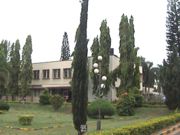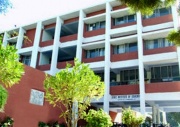| TRAINING PROGRAMME ON LEARNING OUTCOMES
|
| STATE INSTITUTE OF EDUCATION, PORTBLAIR
|
| In collaboration with RIE, Mysuru
|
LET US BEGIN BY LISTENING TO A PRAYER WRITTEN BY RABINDRANATH TAGORE
|
WHERE THE MIND IS WITHOUT FEAR
Where the mind is without fear and the head is held high
Where knowledge is free
Where the world has not been broken up into fragments
By narrow domestic walls
Where words come out from the depth of truth
Where tireless striving stretches its arms towards perfection
Where the clear stream of reason has not lost its way
Into the dreary desert sand of dead habit
Where the mind is led forward by thee
Into ever-widening thought and action
Into that heaven of freedom, my Father, let my country awake
....Rabindranath Tagore
|
INTRODUCTION
|
 RIE Mysore is a constituent of the NCERT, New Delhi and it is concerned with the school and teacher education in Southern India. Click here to know more about RIE Mysore [1]
 State Institute of Education, Port Blair is the apex institution of Andaman and Nicobar Islands which designs and implements professional development programmes for teachers in the islands of Andaman and Nicobar. Click here to to know more about Andaman [2] Background
This is a collaborative effort of the Regional Institute of Education, Mysuru and the State Institute of Education, Port Blair to provide in-service professional development inputs for the teachers of Standard III, V and VIII in Andaman and Nicobar Islands. This need was primarily felt by the SIE, Port Blair to improve the learning outcomes of students in standard III, V and VIII. This need was felt considering the performance of the students on the National Achievement Survey conducted by the NCERT
It is felt that the teachers at the elementary level have diverse needs for in-service professional development. Broadly they may be classified as 'Content Enrichment' and 'Training in Pedagogy of Teaching'. This programme is visualised as a training in Understanding the learning outcomes, designing appropriate pedagogic inputs and assessment tools. This training is meant for teachers of science, mathematics, social studies and english.
|
Why Focus on Learning Outcomes?
|
As stated in section 2.6.2 of the report of the Government of India titled "India: Education for All – Towards Quality with Equity" (2014), To monitor improvement in children’s learning levels and to periodically assess the effectiveness of the education system as whole in terms of student learning, the National Council of Educational Research and Training (NCERT) has been periodically conducting National Achievement Surveys (NAS) since 2001 for Classes III, V and VIII. The purpose of these surveys is to obtain an overall picture of what students in specific Classes know and can do and to use these findings to identify gaps and diagnose areas that need improvement. This information is used to formulate policies and interventions for improving student learning.
Further, as stated by the Minister, MHRD in the document on learning outcomes, The Right of Children to Free and Compulsory Education Act (RTE), 2009 entitles every child in
the age group of 6–14 years to quality education. Though there is a mention of Learning Outcomes in the RTE Act, it has not been properly defined. Keeping this in view, Learning Outcomes for Classes 1st to 8th have now been defined. The document, Learning Outcomes at the Elementary Stage was developed by NCERT at the national level, with inputs from stakeholders at the state and district levels.A teacher, who has to help children achieve these learning outcomes has to be not only aware of them but also should know the ways and means of achieving them.
|
INTRODUCTION
|
This web based training programme was conceptualised by a team of teacher educators from the Regional Institute of Education, Mysuru
|
The National Achievement Survey
|
| With the enactment of ‘The Right of Children to Free and Compulsory Education’ (RTE) Act 2009, government is obligated in ensuring eight years of quality education for all children in the age group 6-14 years. One of the key indicators of quality education is to understand whether children’s learning achievement is improving over time in an equitable manner. To monitor improvement in children’s learning levels and to periodically assess the health of the government education system as a whole, the National Council of Educational Research and Training (NCERT) has been periodically conducting National Achievement Surveys (NAS) since 2001, for Class III, V and VIII. The NAS report gives a national and state-level picture, rather than scores for individual students, schools or districts. The purpose of these assessments is to obtain an overall picture of what students in specific classes know and can do and to use these findings to identify gaps and diagnose areas that need improvement.
|
Where does Andaman and Nicobar Islands stand in the NAS?
|
The National Achievement Survey is undertaken for Class III, V and VIII. Overall, Class III children in 34 states/UTs were able to answer 64% of language items correctly and 66% of mathematics questions correctly. If children in Daman and Div performed at the top of the list with 74 and 77 percent in language and mathematics, the children in Andaman and Nicobar fared at the 16th position but above national average with 66 and 68 percent respectively in language and maths for class III.
Whereas, for standard VIII, students in the Island have performed lower than the national average in language, mathematics, science and social Science. This of course has become a cause of concern for the local administration as well as teachers.
|
The Modality Followed
|
|
The programme inputs for this induction programme are developed jointly by the faculty of the Regional Institute of Education, Mysore and the personnel representing State Institute of Education, Port Blaire. The programme is coordinated by Professor Manjula P Rao and Professor Vasant D. Bhat of RIE, Mysore and Shri Joy B of the SIE, Port Blair. Information about the other team members can be found in the section The Facilitators .
|
|
CONTENTS
|
|
The Modules of this training are arranged under the following three areas
|
|
You may also like to visit the following pages
|
How to Proceed?
|
The details would be worked out in consultation with the SIE, Port Blair.
- The teachers are required to work online with the material, preferably area by area, and complete the activities/ tasks as per instructions provided.
- Each section has a suggested time for completion. Even though a participant is free to proceed at his/her own pace, the time frame may be kept in mind for maintaining efficiency and for enabling face-to-face programme to be scheduled.
- Reading material, supplementary material for classroom transaction have been prepared and incorporated in the training package.
- A A Post Test and aA Post Test will be conducted at the beginning and end of the programme for the award of grade and certificate.
|
Programme Inputs
|
The programme inputs of this web based induction programme consists of
- Primary texts, pdf file attachments and AV clippings developed by the online facilitators,
- Pages from relevent internet sites under different sections,
- Video clippings on different topics and for different training objectives,
- The Book Shelf has a collection of relevent material and also consists of activities to be accomplished by you during the training,
- Web Resources provides you with connections to internet sites which could be of help to you
|
Some Features You May Like to Know
|
|
At the end of every page is a navigation help that allows you to go to any section of the package without having to go to the main page. You would need this help when you want to parallally refer to more than one section of the package.
|
|
WHAT IS THE PURPOSE OF THE PACKAGE?
|
|
|